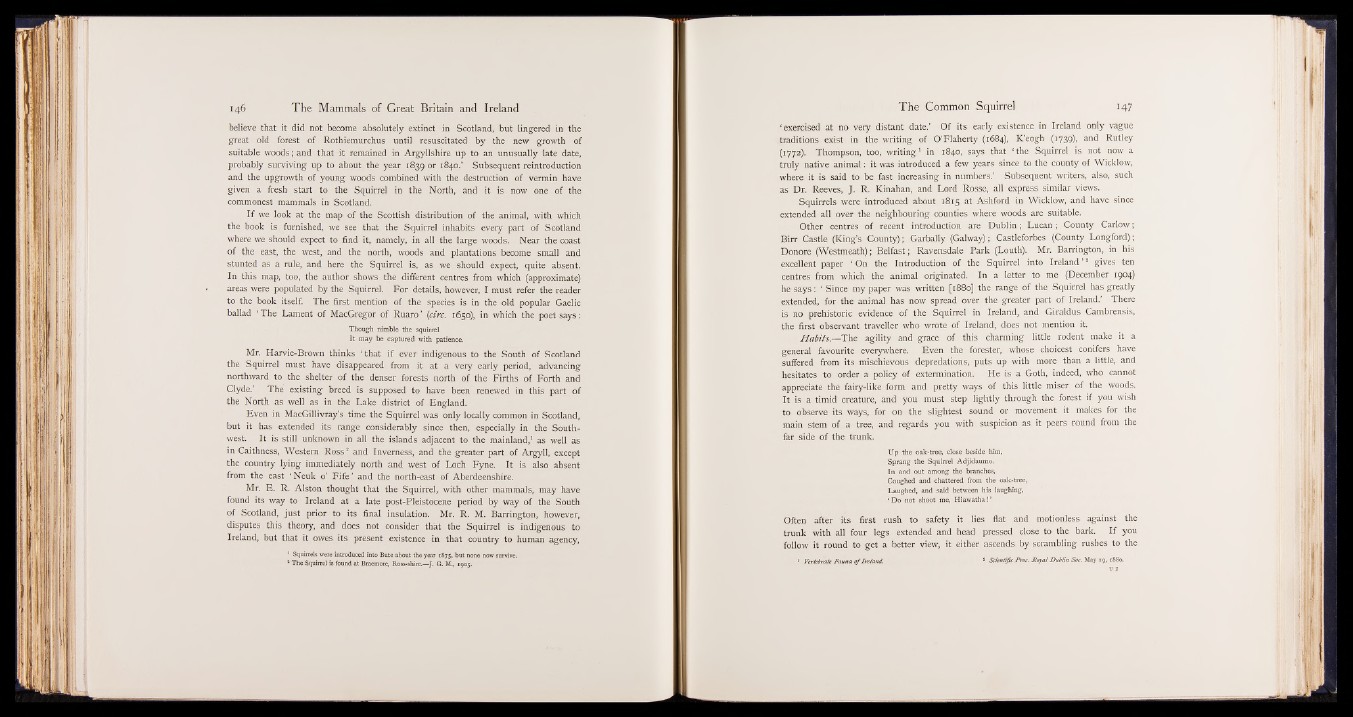
believe that it did not become absolutely extinct in Scotland, but lingered in the
great old forest of Rothiemurchus until resuscitated by the new growth of
suitable woods ; and that it remained in Argyllshire up to an unusually late date,
probably surviving up to about the year 1839 or 1840.’ Subsequent réintroduction
and the upgrowth of young woods combined with the destruction of vermin have
given a fresh start to the Squirrel in the North, and it is now one of the
commonest mammals in Scotland.
I f we look at the map of the Scottish distribution of the animal, with which
the book is furnished, we see that the Squirrel inhabits every part of Scotland
where we should expect to find it, namely, in all the large woods. Near the coast
of the east, the west, and the north, woods and plantations become small and
stunted as a rule, and here the Squirrel is, as we should expect, quite absent.
In this map, too, the author shows the different centres from which (approximate)
areas were populated by the Squirrel. For details, however, I must refer the reader
to the book itself. The first mention of the species is in the old popular Gaelic
ballad ‘ The Lament of MacGregor of Ruaro’ (fire. 1650), in which the poet says:
Though nimble the squirrel
It may be captured with patience.
Mr. Harvie-Brown thinks ‘ that if ever indigenous to the South of Scotland
the Squirrel must have disappeared from it at a very early period, advancing
northward to the shelter of the denser forests north of the Firths of Forth and
Clyde.’ The existing breed is supposed to have been renewed in this part of
the North as well as in the Lake district of England.
Even in MacGillivray’s time the Squirrel was only locally common in Scotland,
but it has extended its range considerably since then, especially in the Southwest.
It is still unknown in all the islands adjacent to the mainland,1 as well as
in Caithness, Western Ross 2 and Inverness, and the greater part of Argyll, except
the country lying immediately north and west of Loch Fyne. It is also absent
from the east ‘ Neuk 0’ Fife ’ and the north-east of Aberdeenshire.
Mr. E . R. Alston thought that the Squirrel, with other mammals, may have
found its way to Ireland at a late post-Pleistocene period by way of the South
of Scotland, just prior to its final insulation. Mr. R. M. Barrington, however,
disputes this theory, and does not consider that the Squirrel is indigenous to
Ireland, but that it owes its present existence in that country to human agency,
1 Squirrels were introduced into Bute about the year 1875, but none now survive.
2 The Squirrel is found at Braemore, Ross-shire.—J. G. M., 1905.
‘ exercised at no very distant date.’ Of its early existence in Ireland only vague
traditions exist in the writing of O’Flaherty (1684), K ’eogh ( i739)> an<^ Rutley
(1772). Thompson, too, writing1 in 1840, says that ‘ the Squirrel is not now a
truly native animal: it was introduced a few years since to the county of Wicklow,
where it is said to be fast increasing in numbers.’ Subsequent writers, also, such
as Dr. Reeves, J . R. Kinahan, and Lord Rosse, all express similar views.
Squirrels were introduced about 18 15 at Ashford in Wicklow, and have since
extended all over the neighbouring counties where woods are suitable.
Other centres of recent introduction are Dublin; Lucan; County Carlow;
Birr Castle (King’s County); Garbally (Galway); Castleforbes (County Longford);
Donore (Westmeath); Belfast; Ravensdale Park (Louth). Mr. Barrington, in his
excellent paper ‘ On the Introduction of the Squirrel into Ireland ’ 2 gives ten
centres from which the animal originated. In a letter to me (December 1904)
he s a y s : ‘ Since my paper was written [1880] the range of the Squirrel has greatly
extended, for the animal has now spread over the greater part of Ireland.’ There
is no prehistoric evidence of the Squirrel in Ireland, and Giraldus Cambrensis,
the first observant traveller who wrote of Ireland, does not mention it.
H abits.—The agility and grace of this charming little rodent make it a
general favourite everywhere. Even the forester, whose choicest conifers have
suffered from its mischievous depredations, puts up with more than a little, and
hesitates to order a policy of extermination. He is a Goth, indeed, who cannot
appreciate the fairy-like form and pretty ways of this little miser of the woods.
It is a timid creature, and you must step lightly through the forest if you wish
to observe its ways, for on the slightest sound or movement it makes for the
main stem of a tree, and regards you with suspicion as it peers round from the
far side of the trunk.
Up the oak-tree, close beside him,
Sprang the Squirrel Adjidaumo.
In and out among the branches,
Coughed and chattered from the oak-tree,
Laughed, and said between his laughing,
‘ Do not shoot me, Hiaw ath a!’
Often after its first rush to safety it lies flat and motionless against the
trunk with all four legs extended and head pressed close to the bark. I f you
follow it round to get a better view, it either ascends by scrambling rushes to the
Vertebrate Fauna o f Ireland. 2 Scientific Proc. Royal Dublin Soc. May 19, 1880.